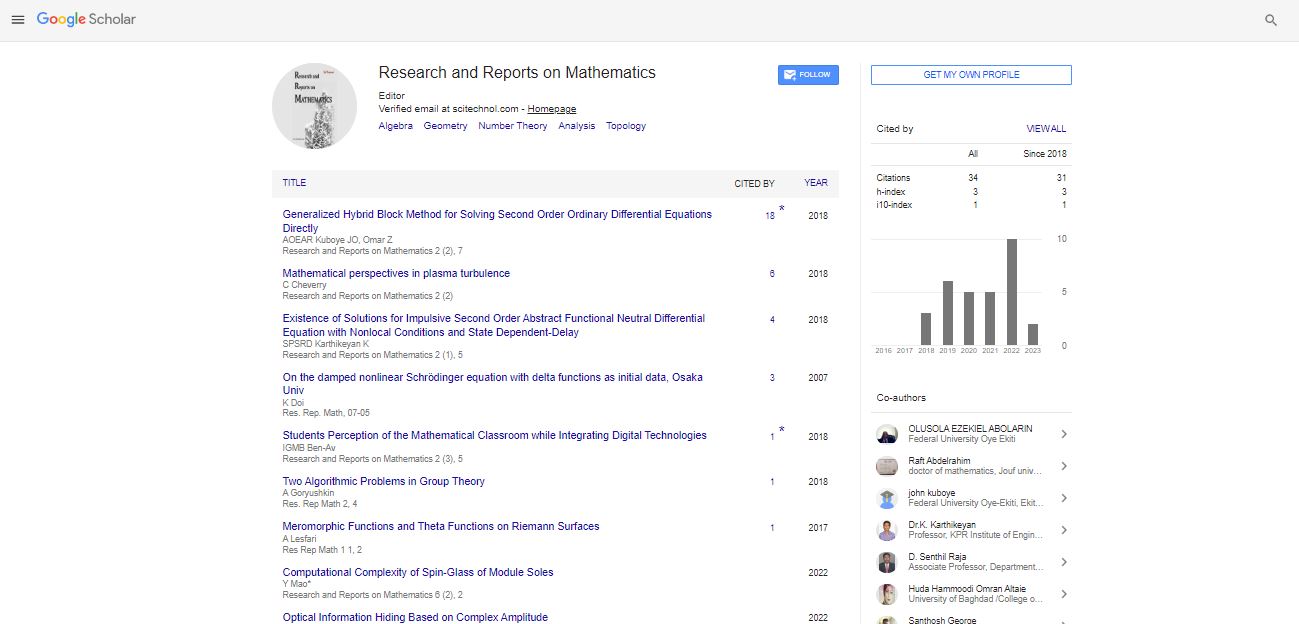Opinion Article, Res Rep Math Vol: 8 Issue: 1
Epidemic Insights: Mathematical Modeling for Disease Control
Nam Soon*
Department of Mathematics and Science, University of Mukuba, Kitwe, Zambia
- *Corresponding Author:
- Nam Soon
Department of Mathematics and Science,
University of Mukuba,
Kitwe,
Zambia
E-mail: namsoon23@gmail.com
Received date: 27 October, 2023, Manuscript No. RRM-23-118500;
Editor assigned date: 30 October, 2023, PreQC No. RRM-23-118500 (PQ);
Reviewed date: 13 November, 2023, QC No. RRM-23-118500;
Revised date: 11 January, 2024, Manuscript No. RRM-23-118500 (R);
Published date: 18 January, 2024, DOI: 10.4172/rrm.1000228
Citation: Soon N (2024) Epidemic Insights: Mathematical Modeling for Disease Control. Res Rep Math 8:1.
Description
Epidemics have shaped human history and continue to pose significant global challenges. Mathematical modeling plays a crucial role in understanding, predicting, and controlling the spread of infectious diseases. In this manuscript, we delve into the world of epidemic modeling, exploring how mathematics provides insights into disease dynamics, transmission, and interventions. We discuss key epidemiological models, the role of data, and the impact of modeling on public health strategies. By examining historical and contemporary examples, we illustrate the power of mathematical modeling in disease control.
Epidemics have been a constant presence throughout human history. From the Black Death in the 14th century to the 1918 influenza pandemic, infectious diseases have had a profound impact on societies. In the modern era, the emergence of new pathogens, such as HIV, SARS, and COVID-19, has emphasized the need for effective strategies to control the spread of infectious diseases. Mathematical modeling has become an indispensable tool in this endeavor.
Mathematical modeling is a powerful and indispensable tool in the realm of disease control. This field applies mathematical principles and techniques to understand, predict, and manage the spread of infectious diseases. Epidemics, pandemics, and endemic diseases all come under the scrutiny of mathematical models. These models help us make sense of complex epidemiological processes, assess the impact of interventions, and guide public health strategies. By quantifying the dynamics of disease transmission, mathematical modeling informs evidence-based decision-making, ultimately contributing to the well-being of populations and the mitigation of public health threats.
The basics of epidemic modeling
The Susceptible-Infectious-Recovered (SIR) model is a foundational epidemiological model that divides the population into compartments to understand disease dynamics. It explores how individuals transition from being susceptible to being infected and, eventually, recovered.
Various extensions and variations of the SIR model exist, including the SEIR model, which incorporates exposed individuals, and the SIRS model, which accounts for temporary immunity. These models capture different aspects of disease transmission and progression.
Mathematical models are only as accurate as the data they are built upon. Collecting and analyzing epidemiological data, such as infection rates, transmission dynamics, and population demographics, are essential for model calibration and validation.
Epidemic modeling in action
We explore historical epidemics, such as the 1918 influenza pandemic and the 2003 SARS outbreak, to showcase how mathematical modeling has retrospectively provided insights into the dynamics of these events. These insights have informed our understanding of disease control.
COVID-19: A contemporary case study
The COVID-19 pandemic has underscored the importance of mathematical modeling in real-time disease control. We discuss how modeling has been used to predict the pandemic's trajectory, inform public health interventions, and assess the impact of various control measures.
Mathematical models help evaluate the effectiveness of public health interventions, including vaccination campaigns, social distancing measures, and quarantine policies. They provide decisionmakers with crucial insights into the potential outcomes of different strategies.
Epidemic modeling is not without challenges. Assumptions made in models may not always align perfectly with the complex and dynamic nature of real-world epidemics. Uncertainty in data and parameter estimation poses challenges for model accuracy.
As we continue to face emerging infectious diseases and complex health challenges, the role of mathematical modeling in disease control is expected to grow. Improvements in modeling techniques, data collection, and collaboration between mathematicians and public health professionals will enhance our ability to respond to epidemics effectively.
Conclusion
Epidemic insights gained through mathematical modeling are invaluable for understanding and controlling infectious diseases. From historical pandemics to contemporary outbreaks, mathematical models have provided insights that guide public health interventions and inform decision-making. As we move forward, the collaboration between mathematical modelers, epidemiologists, and policymakers will be crucial in our efforts to combat epidemics.
 Spanish
Spanish  Chinese
Chinese  Russian
Russian  German
German  French
French  Japanese
Japanese  Portuguese
Portuguese  Hindi
Hindi 